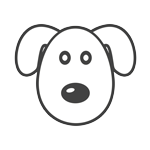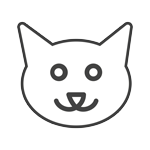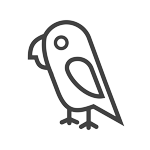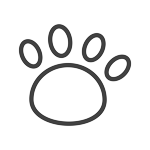
Chow Chow Dog Guide: Traits, Care, Cost & Temperament
The Chow Chow is a breed that commands attention with its lion-like mane, deep-set eyes, and dignified demeanor. Originating from ancient China, this breed has captivated dog enthusiasts worldwide. In this comprehensive guide, we'll delve into the unique traits, care requirements, costs, and temperament of the Chow Chow, providing you with all the information you need to understand this remarkable breed.
Breed Overview
- Origin: Northern China
- Size: Medium to large
- Weight: Males 25–32 kg; Females 20–27 kg
- Height: 43–51 cm
- Lifespan: 8–12 years
- Coat Types: Rough (long) and Smooth (short)
- Colors: Red, black, blue, cinnamon, cream
Unique Traits

Appearance
The Chow Chow's most distinctive feature is its dense double coat, which gives it a plush, teddy bear-like appearance. The breed also boasts a unique blue-black tongue, a trait shared with only a few other breeds. Their deep-set almond eyes and scowling expression contribute to their aura of aloof nobility.
Temperament
Chow Chows are known for their independence and reserved nature. They are often compared to cats due to their aloofness and self-sufficiency. While they are loyal to their families, they may be wary of strangers and require early socialization to ensure well-rounded behavior.
Intelligence and Trainability
This breed is intelligent but can be stubborn, making training a challenge for first-time dog owners. Consistent, positive reinforcement methods work best. Early obedience training and socialization are crucial to prevent behavioral issues.
Care Requirements

Grooming
Chow Chows have high-maintenance grooming needs.
- Brushing: Daily brushing is recommended for rough-coated Chows to prevent matting and reduce shedding. Smooth-coated Chows require brushing several times a week.
-
Bathing: Monthly baths help maintain coat cleanliness.
- Seasonal Shedding: They experience heavy shedding during spring and autumn, necessitating more frequent grooming sessions.
Exercise
Despite their size, Chow Chows have moderate exercise needs.
-
Daily Walks: Two short walks per day are sufficient.
- Playtime: Engaging in interactive play helps stimulate their minds.
- Caution: Due to their thick coats, they are prone to overheating. Exercise should be limited during hot weather.
Diet
A balanced diet is essential for maintaining the Chow Chow's health.
- Protein: Lean meats like chicken and turkey are ideal.
- Fats: Incorporate omega-3 fatty acids from fish to promote coat health.
- Carbohydrates: Whole grains and vegetables provide necessary fiber and nutrients.
- Feeding Schedule: Two meals per day help prevent bloating and maintain energy levels.
Health Considerations
Chow Chows are predisposed to certain health issues:
- Hip and Elbow Dysplasia: Joint malformations that can lead to arthritis.
-
Entropion: A condition where the eyelid rolls inward, irritating the eye.
- Thyroid Issues: Hypothyroidism can lead to weight gain and lethargy.
- Skin Conditions: Their thick coat can trap moisture, leading to infections.
- Heat Sensitivity: Their dense coat makes them susceptible to heatstroke.
Regular veterinary check-ups and a proper care routine can help manage these health concerns.
Cost of Ownership
Initial Costs
- Puppy Price: In Australia, Chow Chow puppies can range from AUD 1,000 to over AUD 8,500, depending on pedigree and breeder reputation.
- Supplies: Initial setup, including bed, leash, bowls, and grooming tools, can cost around AUD 500–1,000.
Ongoing Expenses
- Food: High-quality dog food may cost AUD 100–150 per month.
- Grooming: Professional grooming sessions can range from AUD 80–120 each, recommended every 6–8 weeks.
- Healthcare: Annual veterinary expenses, including vaccinations and check-ups, can total AUD 500–1,000.
- Insurance: Pet insurance premiums vary but average around AUD 50–70 per month.
Chow Chow Variations

Panda Chow
A controversial trend involves grooming and dyeing Chow Chows to resemble pandas. While visually striking, this practice raises ethical concerns regarding animal welfare and the use of dyes on pets. It's essential to prioritize the health and comfort of the dog over aesthetic modifications.
Color Variations
- Black Chow: Solid black coat, exuding elegance and mystery.
- Blue Chow: A dilute black, giving a bluish-gray appearance.
- White Chow: Rare and striking, with a pure white coat.
Each color variation maintains the breed's characteristic traits and requires the same level of care.
Chow Cattle Dog Mix
These Chow Cattle Dog mixes can be a brilliant combination of two very different energy types. While the pure Chow is reserved and often sedentary, the Aussie Cattle Dog brings a burst of working-dog stamina and trainability to the mix.
Pros of the Chow Cattle Dog Mix:
-
More receptive to training
-
Increased energy and agility
-
Better tolerance for heat due to shorter coats
-
Often forms strong bonds with families and children
Watch-outs:
-
May retain the Chow’s stubborn streak
-
Needs both physical and mental stimulation
-
Can become destructive if understimulated
-
Early training and socialisation are a must
Think of them as your “farm dog in a lion’s coat” — they can thrive in both suburban homes and rural properties with space to roam.
Are Chow Chows Easy to Train?

Let’s be honest: Chow Chows are not your typical people-pleasers.
They’re intelligent — but selectively so. If a task doesn’t make sense to them, or if they feel you’ve not earned their respect, they’ll simply refuse. This is not disobedience in the traditional sense. It’s more like aristocratic disinterest.
Training Tips:
-
Keep sessions short and consistent
-
Avoid harsh corrections — they’ll shut down
-
Use food rewards — but rotate treats (they bore easily)
-
Be patient and persistent
Fun fact: Some Chow owners swear their dogs understand full sentences — not because they’re hyper-trainable, but because they quietly observe everything. You'll find they can anticipate your moves if you give them time and trust.
Coping With the Australian Climate
Chow Chows, originally bred for chilly northern Chinese regions, are not naturally suited to hot climates — and the Aussie sun can be unforgiving.
How to Keep Your Chow Cool:
-
Walk only early morning or evening
-
Invest in portable cooling mats or raised dog beds
-
Never shave their double coat — it regulates temperature
-
Keep fresh water accessible in multiple rooms
-
Avoid car rides during heat waves
Chow Chows & Other Pets

Are they good with other animals? It depends.
With Other Dogs:
-
Can be territorial, especially with dogs of the same sex
-
Socialisation from puppyhood helps greatly
-
May not enjoy rough-and-tumble play styles
With Cats:
-
Surprisingly decent — many Chows ignore cats completely
-
Again, early exposure and respectful introduction matter
A Chow raised with other pets will often coexist peacefully, even protectively. But drop a new animal into their domain without ceremony, and you might find yourself in the middle of a royal standoff.
Are Chow Chows Good for Families?
This breed isn’t for everyone, and that’s okay.
Ideal Owners:
-
Calm, experienced dog owners
-
Singles or couples without young children
-
People who enjoy a more “independent” pet
-
Households that can provide structure, quiet, and grooming routines
Less Ideal For:
-
First-time dog owners (unless very committed)
-
Families with toddlers
-
High-energy households expecting a playful dog
But when a Chow Chow does bond with you — it's a bond like no other. Think of it as a quiet, steadfast devotion. They might not wag their tail much, but they’ll follow you from room to room and lean gently against your leg at the end of a long day.
Rare Fact: The Genetic Mystery of the Purple Tongue
Chow Chows (along with Shar-Peis) have a rare gene mutation that causes melanin-rich pigmentation in their mouths and tongues, resulting in the distinct bluish-black tongue. In Chinese folklore, this was believed to be a mark of heavenly origin.
If a Chow Chow doesn’t have this pigmentation, it’s either mixed — or very, very rare.
Lifespan & End-of-Life Care

With proper care, many Chow Chows live 12 to 14 years, with some reaching even 15 or 16. Their slow, steady lifestyle often lends itself to longevity — provided joint issues and heat are well managed.
Senior Chow Tips:
-
Switch to senior dog food at age 8+
-
Provide memory foam dog beds to ease arthritis
-
Increase vet visits to biannual
-
Add gentle joint supplements (glucosamine, chondroitin)
And when the time comes, they often go quietly — the same way they lived: with dignity and quiet loyalty.
Should You Get a Chow Chow?
Only you can answer that. But let’s recap.
Pros:
-
Low-energy, low-barking
-
Loyal without being clingy
-
Stunning looks and quiet presence
-
Perfect for calm, consistent households
Cons:
-
High grooming needs
-
Prone to health issues
-
Can be aloof and stubborn
-
Not ideal for hot climates unless properly managed
If you're seeking a dog that respects your space, watches the world from a quiet corner, and forms a bond that runs deep — a Chow Chow might just be your soul mate in fur.
Your Chow Deserves the Best
At PaWz, we believe every dog deserves comfort, especially breeds as majestic and sensitive as the Chow Chow. From raised cooling beds and orthopaedic foam beds to heavy-duty grooming tools and stylish food bowls, we’ve got everything your regal companion needs.
Explore our collection today and give your Chow the royal treatment it deserves.










Leave a comment